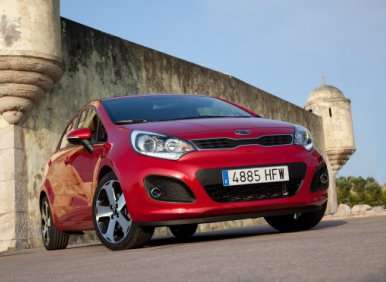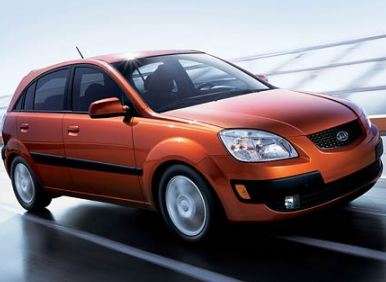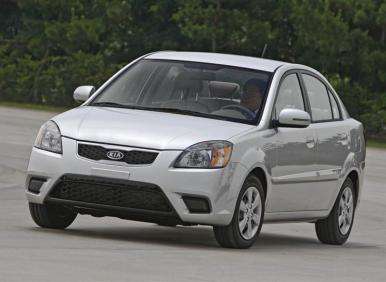Recent Articles
Popular Makes
Body Types
Kia Rio Used Car Buyer’s Guide

The least expensive model from a company known for inexpensive transportation, the Kia Rio walks a pretty fine line. On the one hand, its mission is to provide a good value, but on the other hand it has to meet the expectations of one of the most sophisticated automotive markets on earth.
As Kia learned with the first generation of cars it marketed in the United States, there’s a bit more to it than “build it and they will buy”. Though adored for their affordable pricing, the first round of Kia models was universally panned for their noisy engines, sloppy ride and handling, and cheap-looking interiors.
Over time, Kia got into a groove and today’s Kia models are quite desirable; particularly since the company hired Peter Schreyer, the designer known for his work on such cars as the Audi TT and the Audi A6. Thus, it’s no coincidence the latest round of Kia vehicles look decidedly more upscale.
However, this is a used car retrospective, so we digress; there have been three generations of the Rio offered in the United States since the model was introduced here in 2000 as a 2001 model.
Kia Rio Used Car Buyer’s Guide: 2001 – 2005
The first generation Kia Rio came to the States as a four-door sedan in one state of trim. As was to be expected of the self-described lowest-priced car in America, its feature content was pretty light. A year later, the five-door wagon version of the Rio got its work permit and began doing duty in the U.S. Called the Rio Cinco, it was equipped largely the same as the Rio sedan.
Powering both Kia Rio models was a 96hp, 1.5L inline four-cylinder engine with double overhead cams. And while this doesn't sound like a lot, it's important to keep in mind the 2001 Rio weighed less than 2500 pounds. The front-drive Kia models came with a five-speed manual transmission as standard equipment. A four-speed automatic was optional.
Interestingly, initial reviews were quite positive. However, over time, the complaints began to outweigh the accolades. Over the course of the lifetime of this generation of the Rio, Kia addressed as many of the complaints as they could. This means later models of the GEN1 Rio, might make more sense to pursue as a pre-owned purchase.

Kia Rio Used Car Buyer’s Guide: 2001
Introduced in 2000, as a 2001 model, the Kia Rio came onto the market in one body style, with but one state of trim. Standard features included; a set of 13-inch steel wheels, a temporary spare tire, intermittent windshield wipers, a rear window defogger, a height adjustable drivers seat, front cupholders, front door pockets, a 12V front power outlet, a clock, and a low fuel level warning indicator. The audio system was an AM/FM radio with the buyer’s choice of a CD player or a cassette player.
The 2001 Kia Rio's safety and security suite consisted of a set of front disc/rear drum brakes, a rear center lap belt, electronic brake force distribution, and an emergency interior trunk release.
Options included ABS, air conditioning, alloy wheels, and a tail spoiler.

Kia Rio Used Car Buyer’s Guide: 2002
The Kia Rio Cinco debuted as a five-door compact station wagon for 2002. Standard equipment for this model included 14-inch steel wheels with all season tires and full wheel covers, intermittent windshield wipers, a rear window defogger, a rear window wiper, a height adjustable drivers seat, a front console with storage, front and rear cup holders, front door pockets, and front seat back storage.
Also included in the base price were a speed proportional power steering system, a 12V power outlet, a tilt adjustable steering wheel, a cargo area light, dual vanity mirrors, and a clock. The instrument panel contained a tachometer and a low fuel level warning indicator. The audio system was an AM/FM stereo head unit with four speakers.
Safety and security gear included child seat anchors, ventilated front disc/rear drum brakes, rear door child safety locks, two rear head rests, a rear center lap belt, and electronic brake force distribution.
Many of the features that came standard on the wagon were offered as options for the sedan for 2002. This included power steering, the tachometer, the tilt steering wheel, and the vanity mirrors

Kia Rio Used Car Buyer’s Guide: 2003
For the mid-cycle update in 2003, the front end and wheel covers of both the sedan and wagon were refreshed. The 2003 Kia Rio also got a new 104 hp, 1.6L four-cylinder engine.
Listening to customer complaints, Kia’s product planners specified a revised suspension system to improve ride and handling. The Rio also got new engine mounts and its exhaust system was reworked to improve quietness. To improve steering feel, Kia’s engineers fitted reinforcements to the steering wheel column, to help minimize vibration. The braking system was updated as well.
The instrument cluster was also reworked, as was the center console and door panels. The new door panels incorporated storage bins and bottle holders.
Child seat anchors, rear heater ducts, auto-off headlights, and variable intermittent windshield wipers were added to the standard feature set. The Cinco wagon got a CD player as standard equipment, but the Rio sedan still made it optional
Optional packages included the “Upgrade Package”, which included map lights and a sunglass case. The “Power Package” added power windows and power door locks.
For 2004, the Rio Cinco got alloy wheels as standard equipment. Lumbar support was added to the driver’s seat for both cars, and the center console’s armrest got extra padding to improve its comfort.
The first generation of the Kia Rio went into its last model year with no changes.

Kia Rio Used Car Buyer’s Guide: 2006 – 2011
The second generation Rio came to the United States for MY2006 with a new 110-hp, 1.6-liter inline four-cylinder engine with variable intake valve timing. Making 107 foot-pounds of torque, the engine was paired with either a five-speed manual transmission (standard equipment on the sedan) or a four-speed automatic transmission. The four-speed automatic could be fitted to the sedan as an option.
The car was based on a platform shared with its Hyundai Accent corporate cousin. The all-new exterior design permitted a more spacious interior, thanks to its larger dimensions. Once again offered in four-door sedan and five-door hatchback iterations, the hatch was renamed Rio5 for the new generation of the Kia. Also, where the Rio Cinco was a wagon, the Rio5 looked more like a traditional hatchback.
In addition to their larger size, the GEN2 Rio and Rio5 had more safety features than their predecessors and returned better fuel economy. Topping the list of new safety features was side curtain airbags and side impact airbags. In another change for the new generation—rather than offering the car in one basic state of trim—the GEN2 Rio Sedan had two different trim lines. However, for the first year of production, the Rio5 was offered in but one rather decently equipped state of trim.

Kia Rio Used Car Buyer’s Guide: 2006
For MY2006, the Rio sedan was offered in “base” and “LX” trims, while the Rio5 was offered in a single trim called “SX”. Standard features for the 2006 Kia Rio base sedan included 14-inch steel wheels with partial wheel covers, variable intermittent windshield wipers, a rear window defogger, a height adjustable driver’s seat with manually adjustable lumbar support, a front console with storage, front cupholders, front door pockets, front seat back storage, and a 12V power outlet. The 2006 Rio also featured a trunk light, dual vanity mirrors, a tachometer, and a low fuel level warning indicator.
The safety and security package was comprised of front and rear head airbags, dual front side mounted airbags, child seat anchors, ventilated front disc/rear drum brakes, rear door child safety locks, and auto delayed off headlamps. A rear center three-point belt, front seat belt pre-tensioners, and an emergency interior trunk release completed the package.
The 2006 Kia Rio LX sedan used all of the above plus; full wheel covers, a split folding rear seat back, power steering, a tilt adjustable steering wheel, air-conditioning, and an AM/FM–single CD player audio system with four speakers.
Meanwhile, the 2006 Kia Rio5 SX featured a rear spoiler, 15-inch alloy wheels, a rear window wiper, speed proportional power steering, fog lights, a cargo area light, and leather trim on the shift knob and steering wheel.
Optional for both Rio LX and Rio5 SX was the Power Package, which added full power features, keyless entry and tweeters for the audio system.

Kia Rio Used Car Buyer’s Guide: 2007
The 2007 model year saw the introduction of the Kia Rio SX sedan trim line, which was configured like the Rio5 SX. This meant the adoption of foglights, 15-inch alloy wheels, a rear spoiler, metallic cabin accents, metal pedals, and a black and red cabin theme—in addition to all the features of the Rio LX. A 16-inch alloy wheel was offered as an option for SX models, and the ignition switch was illuminated. For 2007, the five-speed manual transmission was made standard equipment across the board, with the four-speed automatic offered as an option on all models—except the base sedan.

Kia Rio Used Car Buyer’s Guide: 2008
A lower priced version of the Rio5 debuted in LX trim, configured the same as the Rio LX sedan. Also for 2008, Kia offered a limited production Rio5 SX Tuner model, featuring Falken FK452 tires, a Tanabe strut tower brace, and Eibach lowering springs.
For the 2009 model year, all Rio and Rio5 trims received standard Sirius Satellite Radio with a complimentary three-month subscription. All of the Rio’s radios were fitted with a USB port and an auxiliary audio input jack for portable audio devices.
Model year 2010 SX and LX trimmed Kia Rios got Bluetooth. A mild styling update fitted a new grille, headlamps and bumpers, exterior mirrors (with integrated turn signal repeaters), foglights and a rear spoiler. The steering wheel introduced with the Kia Soul and Forte was appropriated for the Kia Rio and Rio5. The wheel incorporated a switch for the optional Bluetooth hands-free phone. Additionally, the instruments got a new red backlit design.
Manual transmissions were dropped from all except the base sedan.

Kia Rio Used Car Buyer’s Guide: 2012 (Current Model)
The third generation Kia Rio debuted in March of 2011, at the Geneva Motor Show in Switzerland. Once again, the car is based on the Hyundai Accent. The GEN3 Rio comes with a 138hp direct injected 1.6L engine with Dual-Continuous Variable Valve Timing. Torque output is rated at 123 foot-pounds.
Transmission options include a six-speed manual and a six-speed automatic. However, the six-speed manual can only be had on the base model sedan. As before, the Rio was offered in both sedan and hatchback (Rio5) formats.
Three trim levels are offered; LX, EX, and SX.
Standard equipment on the LX model includes 15-inch steel wheels, heated exterior mirrors, variable intermittent windshield wipers, a rear window wiper (for Rio5), a rear window defogger, an AM/FM/CD/MP3/Sarellite Radio audio system with four speakers, USB/auxiliary audio input jacks, and audio controls on the steering wheel.
The 2012 Rio LX also features air-conditioning, dual front cupholders, a tilt steering column, a trip computer, a luggage area cover (for Rio 5), and bottle holders in the front doors. The driver’s seat adjusts six ways, and the rear seat folds 60/40.
The safety and security package includes dual front airbags, dual front seat mounted side airbags, full-length side curtain airbags, front seatbelt pre-tensioners, front seatbelt anchors, four disc brakes with ABS, traction control, stability control, electronic brake force distribution, and hill start assist. The 2012 Kia Rio LX also comes with a tire pressure monitoring system, side impact door beams, lower anchors and tethers for children, and rear child safety door locks.
The optional Power Package for Kia Rio LX adds power windows with one-touch auto up/down for the driver’s window, and power door locks with remote keyless entry.
To all of the above, the 2012 Kia Rio EX adds tweeters for the audio system, Bluetooth wireless technology, cruise control with buttons on the steering wheel, a tilt and telescopic steering column, and a center console with a sliding armrest and storage.
The 2012 Kia Rio’s EX Convenience Package adds 15-inch alloys, the Microsoft-developed UVO voice controlled in vehicle infotainment system, a rear camera display, auto on/off headlights, a leather wrapped steering wheel and gearshift knob, turn signal repeaters in the power folding exterior mirrors, front fog lights, dual illuminated vanity mirrors, dual map lights, and a soft touch dashboard
To all of that, the top-of-the-line Rio SX adds17-inch alloy wheels, a sport tuned suspension system, front LED accent lights, front fog lights, LED taillights, dual exhaust tips, and a metal pedal set.
The optional SX Premium Package adds navigation with Sirius XM traffic (which replaces the UVO system), pushbutton start with a smart key, leather seat trim, heated front seats, and a power sunroof.

Kia Rio Used Car Buyer’s Guide: Summary
In terms of features and equipment, a vast chasm separates the first generation Kia Rio from the third generation Kia Rio. Thus, if you're trying to decide which model to purchase, the logical answer is the newest one you can afford. If you're looking at the first-generation Rio, we recommend staying with the 2003 model or newer. That’s when the 104 hp engine was added, as well as all the refinements to make the Rio a more pleasant vehicle.
In terms of reliability, the Kia has proven to be about average. Here’s a real plus though, many of the later models you'll find may still be under the factory powertrain warranty. Kia offers a 10-year/100,000 mile protection package. And while the full 10 years or 100,000 miles are not transferable to a subsequent owner, five years and 60,000 miles of the coverage do follow a used Rio.
(Suddenly a 2008 or better, low-mileage Rio is looking kinda cool—huh?)
There was a big recall for 2006 to 2008 models for an airbag problem, but other than that nothing really stands out. Still, you'd do well to run an Internet search for Kia Rio recalls just to make sure the model you're looking at has no skeletons in its closet.
Similarly, a vehicle history report run against the car’s VIN will help you determine whether the specific examples you're interested in have been subjected to good maintenance procedures or potentially damaging circumstances. As always, a very thorough pre--purchase inspection by trusted professional mechanic familiar with Kia’s automobiles is a must.
